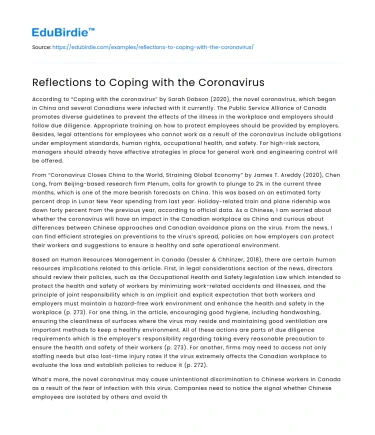According to “Coping with the coronavirus” by Sarah Dobson (2020), the novel coronavirus, which began in China and several Canadians were infected with it currently. The Public Service Alliance of Canada promotes diverse guidelines to prevent the effects of the illness in the workplace and employers should follow due diligence. Appropriate training on how to protect employees should be provided by employers. Besides, legal attentions for employees who cannot work as a result of the coronavirus include obligations under employment standards, human rights, occupational health, and safety. For high-risk sectors, managers should already have effective strategies in place for general work and engineering control will be offered.
From “Coronavirus Closes China to the World, Straining Global Economy” by James T. Areddy (2020), Chen Long, from Beijing-based research firm Plenum, calls for growth to plunge to 2% in the current three months, which is one of the more bearish forecasts on China. This was based on an estimated forty percent drop in Lunar New Year spending from last year. Holiday-related train and plane ridership was down forty percent from the previous year, according to official data. As a Chinese, I am worried about whether the coronavirus will have an impact in the Canadian workplace as China and curious about differences between Chinese approaches and Canadian avoidance plans on the virus. From the news, I can find efficient strategies on preventions to the virus’s spread, policies on how employers can protect their workers and suggestions to ensure a healthy and safe operational environment.
Based on Human Resources Management in Canada (Dessler & Chhinzer, 2018), there are certain human resources implications related to this article. First, in legal considerations section of the news, directors should review their policies, such as the Occupational Health and Safety legislation Law which intended to protect the health and safety of workers by minimizing work-related accidents and illnesses, and the principle of joint responsibility which is an implicit and explicit expectation that both workers and employers must maintain a hazard-free work environment and enhance the health and safety in the workplace (p. 273). For one thing, in the article, encouraging good hygiene, including handwashing, ensuring the cleanliness of surfaces where the virus may reside and maintaining good ventilation are important methods to keep a healthy environment. All of these actions are parts of due diligence requirements which is the employer’s responsibility regarding taking every reasonable precaution to ensure the health and safety of their workers (p. 273). For another, firms may need to access not only staffing needs but also lost-time injury rates if the virus extremely affects the Canadian workplace to evaluate the loss and establish policies to reduce it (p. 272).
What’s more, the novel coronavirus may cause unintentional discrimination to Chinese workers in Canada as a result of the fear of infection with this virus. Companies need to notice the signal whether Chinese employees are isolated by others and avoid this situation. Besides, launching a system for employees to report their status during a pandemic, involving what materials they are required to communicate (and how) to the manager and when they are expected to not report to work is one of the recommendations from the article (Dobson, 2020). Suitable training about protections for staff should be offered by using the learning management system (LMS). However, if staffs have this virus unfortunately, it is important to set reasonable accommodation for them. Having up-to-date sick or leave policies that are clearly communicated to staff and allowing for employees to work at home or in staggered shifts are recommended in the practice due diligence section in the news.
After reading this news and connecting with the textbook, it is significant to ensure health and safety for employers and employees by considering related laws and policies, certifying an eligible work environment and establish a system and accommodations for staff.
References
- Areddy, J. T. (2020, February 3). Coronavirus Closes China to the World, Straining Global Economy. Retrieved from https://www.wsj.com/articles/coronavirus-closes-china-to-the-world-straining-global-economy-11580689793: www.wsj.com
- Dessler, G., & Chhinzer, N. (2018). Human Resources Management in Canada. Library and Archives Canada Cataloguing.
- Dobson, S. (2020, February 04). Coping with the coronavirus. Retrieved from www.hrreporter.com: https://www.hrreporter.com/employment-law/news/coping-with-the-coronavirus/325805






 Stuck on your essay?
Stuck on your essay?

